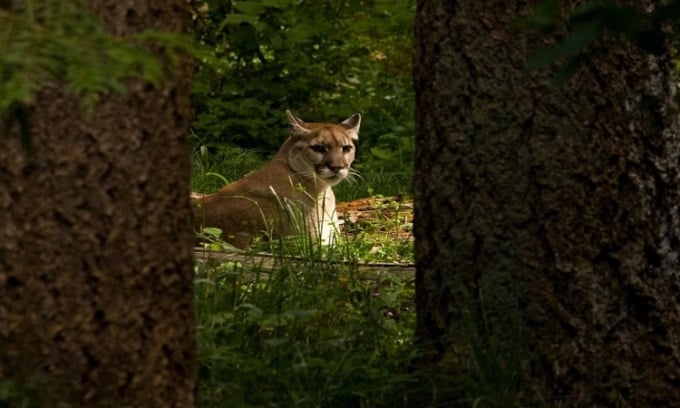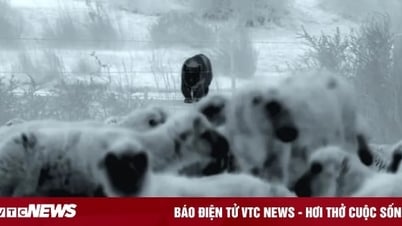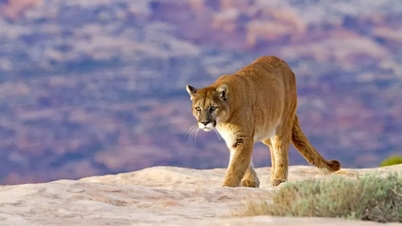US Biologists are searching for the cause of a mass killing of wolves by cougars in Washington state, a behavior very rare in nature.

Cougars in Washington target wolves from several different packs in the area. Photo: National Geographic
A female coyote was wandering along a trail in northeastern Washington last summer when a cougar suddenly jumped out from behind a bush and attacked. After a fierce fight, the cougar bit through the coyote’s skull. It then hid the carcass and ate it later before disappearing into the woods, National Geographic reported on August 25.
The Washington Department of Fish and Wildlife (WDFW) has recorded cougars killing six collared wolves since 2013, accounting for nearly 30 percent of the 21 wild wolf deaths in the state. If the trend continues and represents the entire population in Washington state, that number would be huge, said Trent Roussin, a biologist at WDFW. The wolves killed were from multiple packs in different parts of the state.
Cougar killings of wolves are rare in the western United States, where wolves have been abundant since they were reintroduced to Yellowstone National Park in Wyoming and Idaho in 1995. Today, Montana and Idaho have five times as many wolves as Washington. Biologists in Yellowstone have recorded only two cases of cougars killing wolves in the past 28 years. Similar cases in Idaho and Montana were two and five between 2009 and 2012, respectively.
Wolves were naturally dispersed in Washington in the summer of 2008. Recent counts recorded 216 animals in 37 packs, mostly in the Cascade Range and northeastern timberlands of the state. Wolf packs generally have the advantage over lone cougars. However, cougars would have the upper hand in a one-on-one ambush.
The first wolf-by-cougar death in Washington was in 2013, an underweight female wolf traveling in the Cascade Range. Cougars killed a 2-year-old male wolf from the Teanaway pack in March 2014. A month later, a 6-year-old male wolf from the Smackout pack was killed near a nest. Researchers also documented the killing of a 7-year-old female wolf in 2019, and a nearly 1-year-old female and a pup last September.
Biologists detected the trend using radio collars. When a coyote hasn’t moved for eight hours, the collar will emit a signal. The team picks up the collar and pieces together what happened. Investigators initially look for signs of poaching, a common cause of death. They also check the crime scene for animal tracks, feces, and the location of the coyote carcass. The neatly hidden carcass suggests the crime was a puma. The autopsy confirmed it, with two holes in the skull.
Interactions between wolves and cougars appear to vary by habitat. Researchers have found wolves killing many cougar cubs in the Teton Range. But cougars rarely attack wolves. Biologists have not documented cases of wolves killing cougar cubs or pups in Washington.
Without a large enough sample to draw conclusions, Roussin speculates that habitat differences may help explain the high number of cougars killing wolves in Washington state. The state has steep mountains, many narrow canyons, and few open grasslands, which may give cougars the upper hand. Other factors that may contribute to the behavior include cougar density or wolf pack size, he says.
An Khang (According to National Geographic )
Source link


![[Photo] General Secretary concludes visit to Azerbaijan, departs for visit to Russian Federation](https://vphoto.vietnam.vn/thumb/1200x675/vietnam/resource/IMAGE/2025/5/8/7a135ad280314b66917ad278ce0e26fa)

![[Photo] President Luong Cuong presents the decision to appoint Deputy Head of the Office of the President](https://vphoto.vietnam.vn/thumb/1200x675/vietnam/resource/IMAGE/2025/5/8/501f8ee192f3476ab9f7579c57b423ad)
![[Photo] National Assembly Chairman Tran Thanh Man chairs the meeting of the Subcommittee on Documents of the First National Assembly Party Congress](https://vphoto.vietnam.vn/thumb/1200x675/vietnam/resource/IMAGE/2025/5/8/72b19a73d94a4affab411fd8c87f4f8d)
























![[Photo] General Secretary To Lam receives leaders of typical Azerbaijani businesses](https://vphoto.vietnam.vn/thumb/1200x675/vietnam/resource/IMAGE/2025/5/8/998af6f177a044b4be0bfbc4858c7fd9)

































![[Photo] Prime Minister Pham Minh Chinh talks on the phone with Singaporean Prime Minister Lawrence Wong](https://vphoto.vietnam.vn/thumb/402x226/vietnam/resource/IMAGE/2025/5/8/e2eab082d9bc4fc4a360b28fa0ab94de)

































Comment (0)